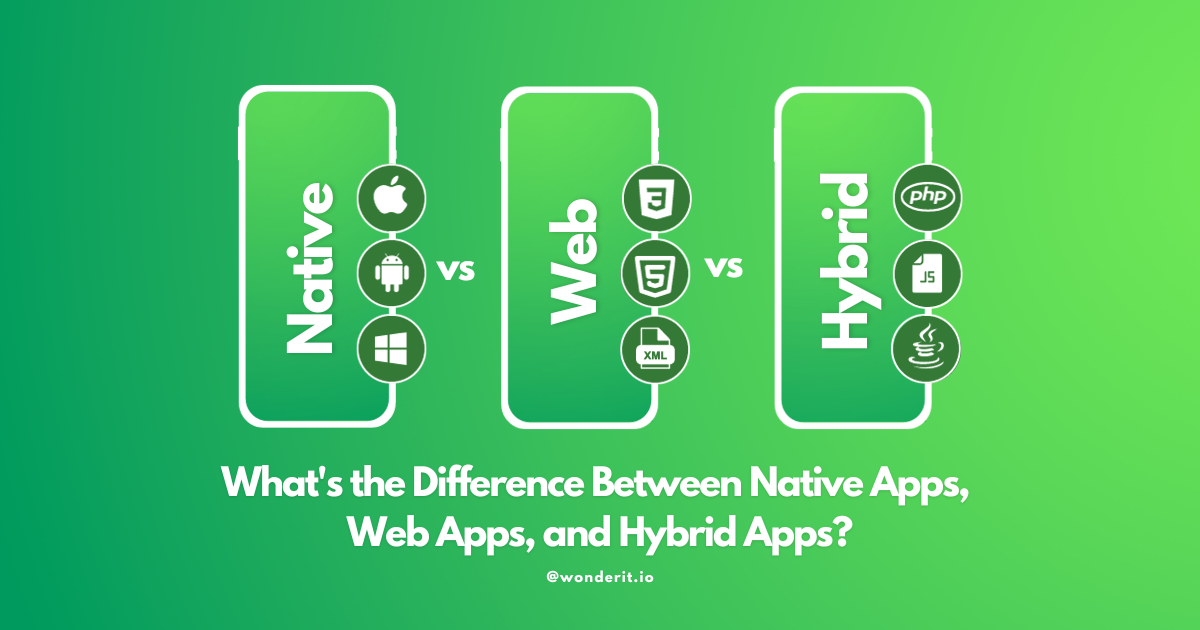Applications have become an essential part of our life in the current digital age, enabling us to communicate with clients and help them complete particular tasks. These applications, including web apps, native and hybrid apps have come in various forms, depending on their development methods and functionalities. This article delves into the differences between these app types, exploring their development, functionality, and user experience.
The Evolution of Application Development
The story of application development traces its roots back to the early days of computers. During this era, when desktops and personal computers reigned supreme, applications were primarily installed on-site, either within a company’s premises or data centre, and their functionalities were delivered through corporate networks. Most of these early applications followed a client-server architecture, with data stored and processed on on-premises servers. Users were required to install client applications on their devices, resulting in a need for different client app versions for various platforms. For example, a Windows machine demanded a different version from a Linux machine.
As the internet began its rapid expansion, geographical boundaries blurred, and servers and clients could be situated anywhere across the globe. This shift paved the way for web applications, which offered greater reach and flexibility than their predecessors. Unlike traditional client-server applications, web apps allowed users to access application functionality directly through web browsers. Simultaneously, the emergence of mobile devices introduced new platforms for application delivery, granting users the freedom to choose between accessing software via a browser or by installing dedicated apps on their preferred devices.
Challenges in Modern App Development
The modern landscape presents a unique set of challenges for businesses involved in application development. Some of these challenges include:
Diverse User Groups: In today’s world, businesses must cater to various user groups, leading to the development of different types of web and mobile applications. These may include web apps for users who prefer browser-based work, Windows and macOS applications for desktop users, Android apps for Android mobile devices, and iOS apps for Apple devices.
Language and Platform Diversity: App developers now face the daunting task of writing the same software in multiple languages to ensure compatibility across various platforms. This multiplies the effort required for new feature releases, bug fixing, and software maintenance, leading to increased time and costs.
Design Solutions: In response to these challenges, various design solutions, such as containers and service-oriented architectures, have been introduced. These innovative design approaches have given rise to different types of web and mobile applications, each with its unique attributes.
Choosing the Right Mobile App: Native, Web, or Hybrid
Once you’ve decided to venture into the mobile app world, the critical question you’ll face is: What type of mobile application is best for your needs? There are three main options to consider: native, hybrid, and web apps. In this article, we’ll delve into the characteristics, advantages, and disadvantages of each, helping you make an informed choice for your business.
Native Mobile Applications
Native mobile applications are tailor-made for a specific platform, such as iOS or Android, utilising platform-specific programming languages and tools. This approach ensures seamless integration with the device’s native functionalities, offering optimal performance and user experience.

Pros of Native Mobile Applications:
- Access to Device Hardware: Native apps can tap into device-specific features like GPS, camera, microphone, and sensors, providing enhanced functionality.
- Superior Performance: Leveraging the platform’s native capabilities and programming languages results in faster response times.
- Enhanced User Experience: Native apps are designed to match the device’s native UI, delivering a familiar and intuitive interface.
- User Data Collection: Collecting and analysing user data is more efficient, along with push notifications, a crucial element for marketing efforts.
- Offline Operation: Native apps can function without a stable internet connection once installed.
Cons of Native Mobile Applications:
- Higher Development Costs: Building separate native apps for various platforms requires more time and resources.
- Multiple Codebases: Maintaining separate codebases for different platforms increases development time and maintenance efforts.
- Longer Approval Process: Native apps must go through an approval process on respective app stores.
Web Mobile Applications
Web mobile applications are essentially mobile-optimised websites that users access through web browsers, eliminating the need for app store installations. They’re particularly suitable as companions to native apps, offering users access without taking up space on their devices.

Pros of Web Mobile Applications:
- Platform Independence: Web apps run on any device with a compatible web browser, making them accessible across different platforms.
- Lower Development Costs: Building web apps typically requires fewer resources compared to native or hybrid apps.
- Faster Development: The use of web technologies like CSS, HTML, and JavaScript speeds up development cycles, and no app store approvals are necessary.
- Easy Updates: Web apps can be updated in real-time without requiring users to download or install updates.
Cons of Web Mobile Applications:
- Limited Access to Device Features: Web apps have restricted access to device-specific features like the camera, sensors, and more, limiting their functionality.
- Performance Dependent on Connectivity: Web apps rely heavily on internet connectivity, which can result in slower loading times and limited offline functionality.
- Reduced Visibility: Web apps aren’t catalogued in one central location like app stores, making them harder to find and market.
Hybrid Mobile Applications
Hybrid mobile apps combine elements of web and native applications. They offer a native-like experience across multiple platforms and operating systems while being available for download from app stores.
An illustrative instance of a hybrid mobile application can be found in the Facebook app, which provides users with a native-like interface across a wide range of smartphones and offers functionalities such as messaging, live streaming, and group interactions.

Pros of Hybrid Mobile Applications:
- Cross-Platform Compatibility: Hybrid apps run on multiple platforms, reducing development time and costs.
- Fast Development Cycles: Leveraging web technologies allows for rapid prototyping and quicker iterations.
- Easy Maintenance: Updates can be made to the web codebase, reflecting changes across all platforms.
Cons of Hybrid Mobile Applications:
- Limited Access to Device Features: Access to device features may be limited, affecting performance, especially in highly graphical or complex apps.
- Performance Limitations: Complex or resource-intensive applications may experience performance issues.
- Frameworks Dependency: Hybrid apps rely on frameworks like Flutter or React Native, introducing potential complexities and limitations.
- Brand Consistency: Hybrid apps adapt to the operating system, which can result in variations in appearance.
Key Considerations for Choosing Between Native, Hybrid, or Web Apps
Selecting the right type of mobile app for your business is a pivotal decision. Whether you’re a startup entrepreneur, a seasoned business owner, or somewhere in between, the choice between native, hybrid, or web apps can have a significant impact on your project’s success. Here are some key considerations that can help you determine which option is the best fit for your unique needs:
Timeframe – How soon do you need a mobile app? Native apps, designed specifically for one platform, often require more development time. In contrast, web and hybrid apps can be quicker to develop, making them ideal if you have a tight schedule to meet.
Budget – What’s your budget for the app development project? It’s important to acknowledge that native apps can be more expensive due to the need for separate development for each platform. Web and hybrid apps tend to be more cost-effective alternatives, making them a viable choice for businesses with limited financial resources.
Feature Requirements – Consider the features you want to include in your app. Native apps often offer advanced functionality and the ability to implement cutting-edge features. Carefully assess your feature requirements and evaluate whether a native app is necessary to achieve your goals.
Business Goals – How will the app serve your business priorities, and what outcomes are you hoping to achieve by offering an app to your customers? Your business objectives can play an important role in determining the type of app that aligns with your overall strategy.
Platform Targeting – Are you catering to a specific platform, or do you intend to create a cross-platform solution compatible with various operating systems? Understanding your target audience and their preferred platforms will influence your choice.
User Experience – What kind of user experience do you aim to provide? A seamless and enjoyable user experience is crucial for the success of your app. While web apps can deliver a strong user experience, native apps often provide a more straightforward means to achieve this goal.
Offline Accessibility – Consider how important offline connectivity is for your app. Web apps typically require an internet connection for access, while native apps can offer some degree of offline functionality. Assess your users’ needs and connectivity requirements accordingly.
Update Frequency – How often do you plan to release updates to your app? Native and hybrid apps often necessitate users to visit app stores for updates, which can impact user convenience. Web apps can be updated more flexibly, reducing friction for users.
Now that you’ve contemplated these essential questions, you’re better equipped to make an informed decision regarding the type of app that suits your business goals.
If you’re ready to embark on your app development journey, WonderIT is here to offer you skilled mobile app development services. Our experts efficiently create apps that resonate with your users, paving the way for your digital success. Contact WonderIT today to get started on your app development journey.
Choosing the Right App Type for Your Business
Now that you’ve gained insight into the world of mobile app development, let’s delve into which type of application best aligns with your business’s unique needs. Native, web, and hybrid apps each have their own set of advantages and drawbacks, and selecting the right one is pivotal for achieving success.
Native Apps: If your business boasts a substantial budget, native apps emerge as an enticing choice. These apps are renowned for their high performance and delivering a consistent, platform-specific user experience. Investing in native app development can provide your users with a polished and seamless interface, enhancing your brand’s image.
Web Apps: For startups or smaller businesses with budget constraints, web applications offer an affordable and practical solution. They are accessible across various platforms, making them an ideal choice for businesses aiming to establish an online presence without the higher costs associated with native app development.
Hybrid Apps: If your business lies somewhere in between and seeks visibility on multiple app marketplaces without the complexity of managing separate iOS and Android apps, hybrid apps could be the right fit. These apps combine elements of both native and web apps, offering a versatile approach to app development.
Summary
In summary, the differences between web apps, native apps, and hybrid apps encompass functionality, user experience, performance, development, and customer reach. Businesses must carefully consider their goals, target audience, and the complexity of their app’s functionality when choosing the most suitable app type for their needs. This decision can significantly impact development timelines, costs, and the overall success of the application.
We offer a wide range of mobile and web application development services, from project definition to implementation and maintenance. Whether you need a native iOS or Android app, a hybrid solution, or a web app, our experienced team of developers can help you make the right choice and bring your vision to life. If you’re ready to take your business to the next level with innovative mobile and web applications, contact us today for a consultation.


Recent Comments